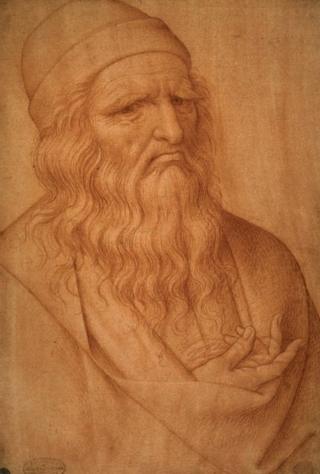Leonardo’s ‘claw hand’ stopped him painting
 Image copyright Museum of Gallerie dell’Accademia, Venice
Image copyright Museum of Gallerie dell’Accademia, Venice Leonardo da Vinci could have experienced nerve damage in a fall, impeding his ability to paint in later life, Italian doctors suggest.
They diagnosed ulnar palsy, or “claw hand”, by analysing the depiction of his right hand in two artworks.
It had been suggested that Leonardo’s hand impairment was caused by a stroke.
But in the Journal of the Royal Society of Medicine, the doctors suggest it was nerve damage that meant he could no longer hold a palette and brush.
Leonardo da Vinci, who lived from 1452-1519, was an artist and inventor whose talents included architecture, anatomy, engineering and sculpture, as well as painting.
But art historians have debated which hand he used to draw and paint with.
Analysis of his drawing shows shading sloping from the upper left to lower right, suggesting left-handedness. But all historical biographical documents suggest Leonardo used his right hand when he was creating other kinds of works.
‘A certain paralysis’
For this research, two artworks – showing Leonardo da Vinci in the latter stages of his life – were analysed. One is a portrait of the artist, drawn with red chalk, attributed to the 16th-century Lombard artist Giovanni Ambrogio Figino.
Unusually, it shows his right arm largely concealed in folds of clothing. His hand is visible, but in a “stiff, contracted position”.
- Leonardo da Vinci portrait marks 500th anniversary of his death
- Leonardo da Vinci’s ‘living relatives’ identified
Dr Davide Lazzeri, a specialist in plastic reconstructive and aesthetic surgery at the Villa Salaria Clinic in Rome, who led the analysis, said: “Rather than depicting the typical clenched hand seen in post-stroke muscular spasticity, the picture suggests an alternative diagnosis such as ulnar palsy, commonly known as ‘claw hand’.”
The ulnar nerve runs from the shoulder to the little finger, and manages almost all the intrinsic hand muscles that allow fine motor movements, so a fall could have caused trauma to his upper arm, leading to the palsy, or weakness.
There are no reports of any cognitive decline or other motor impairment, which offers further evidence that a stroke was an unlikely cause of Leonardo’s impairment. Dr Lazzeri said.
He added: “This may explain why he left numerous paintings incomplete, including the Mona Lisa, during the last five years of his career as a painter, while he continued teaching and drawing.”
A further image, an engraving of a man playing a lira da braccio – a Renaissance string instrument – was examined. The man in the engraving was recently identified as Leonardo da Vinci. Further evidence was obtained from a diary entry by a Cardinal’s assistant about a visit to the artist’s house in 1517.
The assistant, Antonio de Beatis wrote: “One cannot indeed expect any more good work from him as a certain paralysis has crippled his right hand… And although Messer Leonardo can no longer paint with the sweetness which was peculiar to him, he can still design and instruct others.”

